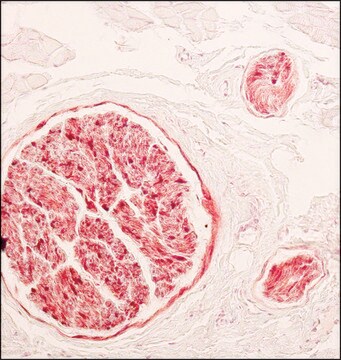AB7356
Anti-von Willebrand Factor Antibody
Chemicon®, from rabbit
Synonym(s):
Factor VIII Related Antigen
About This Item
Recommended Products
biological source
rabbit
Quality Level
antibody form
purified immunoglobulin
antibody product type
primary antibodies
clone
polyclonal
species reactivity
human, rat, mouse
packaging
antibody small pack of 25 μg
manufacturer/tradename
Chemicon®
technique(s)
ELISA: suitable
immunohistochemistry: suitable (paraffin)
NCBI accession no.
UniProt accession no.
shipped in
ambient
storage temp.
2-8°C
target post-translational modification
unmodified
Gene Information
human ... F8(302470) , VWF(7450)
rat ... F8(302470)
General description
Specificity
Immunogen
Application
ELISA Analysis: A representative lot detected von Willebrand Factor in ELISA applications.
Immunohistochemistry Analysis: A 1:250-1,000 dilution from a representative lot detected von Willebrand Factor in human cerebral cortex, mouse hippocampus, rat cerebellum and human tonsil tissue sections.
Cell Structure
ECM Proteins
Quality
Representative images from a previous lot.
Rabbit anti-vWF (AB7356) staining of Human Cerebral Cortex. Tissue pretreated with Citrate Buffer, ph 6.0, anti-vWF at 20 μg/mL, IHC-Select Detection with HRP-DAB.
Target description
Physical form
Storage and Stability
Other Notes
Legal Information
Disclaimer
Not finding the right product?
Try our Product Selector Tool.
recommended
Storage Class Code
12 - Non Combustible Liquids
WGK
WGK 2
Flash Point(F)
Not applicable
Flash Point(C)
Not applicable
Certificates of Analysis (COA)
Search for Certificates of Analysis (COA) by entering the products Lot/Batch Number. Lot and Batch Numbers can be found on a product’s label following the words ‘Lot’ or ‘Batch’.
Already Own This Product?
Find documentation for the products that you have recently purchased in the Document Library.
Customers Also Viewed
Our team of scientists has experience in all areas of research including Life Science, Material Science, Chemical Synthesis, Chromatography, Analytical and many others.
Contact Technical Service







